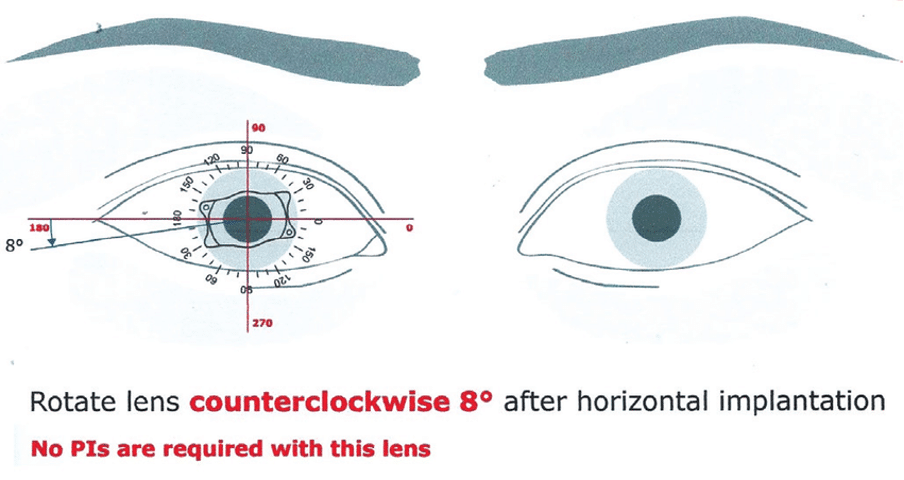ICLs have reshaped the scene of vision correction since 1993. Doctors have implanted these lenses in more than 1 million eyes worldwide. These lenses work differently than traditional methods. They sit inside your eye instead of on the surface and give you a permanent fix for nearsightedness without changing your cornea’s structure.
These implants could be perfect for you if you’re fed up with daily contacts or nervous about laser surgery. You’ll see results almost right away and won’t need much recovery time. Most patients end up with crystal-clear vision after the procedure. Eye clinics report soaring wins in helping patients achieve 20/20 vision. The lenses stay firmly in place inside your eye and are a great way to get lasting vision correction. You won’t have to deal with glasses or the daily grind of contact lens care anymore.
This piece will walk you through all you need to know about implantable contact lenses. We’ll cover how they work, their most important benefits, what happens during surgery, and things to think about for the future.
What Are Implantable Contact Lenses and How Do They Work?
Implantable contact lenses are transforming vision correction with their unique approach that works differently from regular glasses or external contact lenses. These tiny, flexible devices give you clear vision and become completely invisible once they’re in place.

Placed inside the eye, not on the surface
Regular contact lenses sit on your cornea, but implantable contact lenses (ICLs) go inside your eye through a minimally invasive surgery. Doctors place them behind your iris (the coloured part of your eye) and in front of your natural lens. You won’t feel the lens because of this internal placement, and no one can see it. The ICL becomes invisible both to you and anyone looking at your eye.
Corrects vision by bending light internally
ICLs use the same basic principle as external corrective lenses—they bend light rays entering your eye. All the same, ICLs create sharper vision from inside the eye without touching your cornea’s surface. These amazing lenses can fix several vision problems, including:
- Shortsightedness (myopia), even high prescriptions up to -20
- Longsightedness (hyperopia) up to +10
- Astigmatism up to +6
Light moves to focus exactly on your retina, which gives you crystal-clear vision without changing your eye’s natural structures. Your cornea stays untouched and your natural lens remains in place, so doctors can reverse the procedure if needed.
Made from biocompatible material for long-term use
STAAR Surgical makes the EVO Visian ICL from Collamer, their exclusive biocompatible material. This innovative material combines collagen (a natural substance in your body) with polymer, creating a lens that works perfectly with your eye’s natural chemistry. The Collamer composition includes:
- 60% poly-hydroxymethylmethacrylate (HEMA)
- 36% water
- 3.8% benzophenone
- 0.2% porcine collagen
This special mix makes ICLs light, flexible, and compatible with your eye’s biological environment. The material also protects your eyes from harmful UV rays that can lead to various eye conditions.
Top Benefits of Choosing Implantable Contact Lenses
ICLs provide exceptional advantages compared to regular vision correction methods. These modern lenses give excellent visual results with few drawbacks. They’re an outstanding choice for patients who want to break free from glasses and regular contacts.

1. Clearer vision with natural corneal shape
ICLs deliver crystal-clear, high-definition vision because they work with your eye’s natural structure. Your cornea keeps its original shape, unlike laser surgery that reshapes it. Patients often describe their vision as more vivid and clearer than what they had with glasses or traditional contacts. They notice details and colours with amazing clarity after the procedure.
2. No dry eye issues post-surgery
ICLs stand out because they don’t cause dry eye syndrome. The procedure leaves corneal nerves completely undisturbed. This helps patients avoid dry eye problems that often come with laser surgeries. ICLs work great for people who struggle with eye dryness or want to avoid this uncomfortable side effect.
3. Ideal for high prescriptions and thin corneas
ICLs shine at fixing severe vision problems that other procedures can’t handle. They work great for people with high degrees of shortsightedness, longsightedness, or astigmatism. These lenses also help people with thin corneas who can’t get laser surgery.
Not suitable for LASIK? Implantable Contact Lenses (ICLs) offer a safe, reversible, and long-lasting solution for high prescriptions and dry eyes. Book your ICL consultation today with the experts at Precision Vision London and find out if it’s the right choice for your vision.
4. Reversible and low-maintenance
Your vision needs might change, and ICLs can be removed or replaced when needed. This flexibility gives peace of mind without affecting visual clarity. The lenses work perfectly once placed and need no maintenance.
5. Better night vision and contrast sensitivity
Patients usually see better at night after ICL surgery. Research shows ICLs boost contrast sensitivity, especially at high spatial frequencies. You’ll notice improved vision in tough lighting conditions with fewer problems like glare or halos.
6. No daily cleaning or lens care needed
Life becomes easier without daily contact lens care. You won’t need cleaning solutions, cases, or nightly lens removal. ICLs stay in place and work round the clock, giving clear vision from morning till night without any maintenance.
Understanding the ICL Procedure and Recovery
Your path to clear vision with implantable contact lenses starts before the actual procedure.

Original consultation and eye measurements
A full picture of your eyes determines if ICLs suit you. The assessment has specialised tests that measure corneal endothelial cell count, anterior segment imaging, and precise biometry to confirm adequate space for lens placement. These measurements play a vital role in determining your implant’s exact dimensions.
Surgery process: quick and minimally invasive
The ICL procedure takes just 10-15 minutes per eye. The surgeon creates a tiny 2-3mm incision in your cornea under local anaesthesia and light sedation. Your folded lens slides through this opening and sits behind your iris, where it naturally unfolds into place. The small incision heals on its own, so stitches aren’t usually needed.
Recovery timeline and what to expect
You might notice mild discomfort and bloodshot eyes with temporary vision blur at first. Most patients achieve driving-standard vision within 24 hours. Full recovery typically takes about four weeks. Your vision keeps getting better over six months gradually.
Post-op care and follow-up appointments
You’ll need antibiotic and anti-inflammatory eye drops for 2-4 weeks after surgery. The first check-up happens within 1-2 days. More appointments follow at one week, one month, and three to six months. Yearly check-ups help ensure your eyes stay healthy for the long term.
Risks, Limitations, and Long-Term Considerations
Implantable contact lenses give excellent vision correction, but you need to know what it all means before making your choice.
Potential for increased eye pressure
Eye pressure problems make up about 10.8% of complications after ICL surgery. The patient’s response to steroids causes 64% of these cases, along with leftover surgical material and blocked pupils. The good news is that newer ICL designs with holes in the middle have made these risks much lower.
Cataract development in rare cases
You’ll be glad to know that serious cataracts only happen in 1.96% of cases over five years. People over 40, those with severe myopia (beyond -12D), smaller eye chambers, and men face higher risks. Regular eye checks and proper screening will help manage this risk.
How long do implantable contact lenses last?
ICLs are made from special Collamer material that can last throughout your life. Your lenses will stay stable if you take care of your eyes and avoid injury. These lenses keep working well even as you get older.
Importance of regular check-ups
Your doctor needs to see you every year after your recovery appointments. These visits let eye specialists check your pressure levels, see how your lenses sit, and spot any early warning signs. This careful monitoring will give a better outcome over time.
Implantable contact lenses cost in the UK
UK patients pay between £3,000 and £4,500 for each eye for ICL surgery. Most eye clinics charge around £3,595 per eye. This price has everything you need – consultation, surgery, and aftercare. You’ll find many clinics offer payment plans to help spread the cost.
Conclusion
Implantable contact lenses are a game-changing advancement in vision correction technology. These innovative lenses free you from the daily hassle of traditional contacts and preserve your eye’s natural structure. Your cornea stays untouched, unlike laser procedures that permanently alter it. ICLs work naturally with your eye’s anatomy and deliver exceptional visual clarity without causing dry eye syndrome.
The path to better vision starts with a detailed consultation followed by a quick, minimally invasive procedure. You can achieve driving-standard vision within 24 hours, though full recovery takes about four weeks. ICLs provide a safe, reversible, and lasting solution if LASIK isn’t right for you, especially with high prescriptions and dry eyes. The experts at Precision Vision London can help you discover if ICLs match your vision needs through a consultation.
ICLs’ long-term value becomes evident through their potential lifetime durability with proper care and regular check-ups. The original investment ranges between £3,000 and £4,500 per eye in the UK. Many patients find this cost worth it due to ICLs’ unique visual quality and convenience.
Your choice to get implantable contact lenses should align with your vision needs, lifestyle priorities, and eye health. These remarkable lenses give you the best of both worlds – permanent vision correction’s stability and the peace of mind of reversibility if needed. This balance makes ICLs a popular choice for people who want freedom from glasses and traditional contacts while enjoying crystal-clear vision.
Key Takeaways
Implantable contact lenses offer a revolutionary vision correction solution that works inside your eye, providing exceptional clarity whilst preserving your natural corneal structure.
- ICLs correct high prescriptions up to -20 dioptres without altering corneal shape, making them ideal for patients unsuitable for laser surgery.
- The procedure takes just 10-15 minutes per eye with most patients achieving driving-standard vision within 24 hours of surgery.
- Unlike laser surgery, ICLs are completely reversible and don’t cause dry eye issues since corneal nerves remain undisturbed.
- Made from biocompatible Collamer material, these lenses can potentially last a lifetime with proper care and annual check-ups.
- UK costs range from £3,000-£4,500 per eye, but many find this justified by the exceptional visual quality and maintenance-free convenience
ICLs represent the perfect balance between permanent vision correction and peace of mind, offering those with high prescriptions or thin corneas a safe, effective alternative to traditional methods whilst maintaining the option for future changes if needed.
FAQs
Q1. How does ICL differ from LASIK surgery? ICL surgery involves implanting a lens inside the eye without altering the cornea, while LASIK reshapes the cornea. This makes ICL suitable for those with thin corneas or high prescriptions, and it doesn’t cause dry eye issues often associated with LASIK.
Q2. What vision problems can implantable contact lenses correct? Implantable contact lenses can correct a wide range of refractive errors, including shortsightedness up to -20 dioptres, longsightedness up to +10 dioptres, and astigmatism up to +6 dioptres.
Q3. How long does the ICL procedure take and what’s the recovery like? The ICL procedure typically takes 10-15 minutes per eye. Most patients achieve driving-standard vision within 24 hours, with complete recovery taking about four weeks. Vision continues to improve gradually over six months.
Q4. Are implantable contact lenses permanent? While implantable contact lenses can potentially last a lifetime, they are also reversible. If needed, they can be removed or replaced if your vision needs change in the future.
Q5. What is the cost of ICL surgery in the UK? In the UK, ICL surgery typically costs between £3,000 and £4,500 per eye. Most clinics offer a comprehensive package price of around £3,595 per eye, which usually includes consultation, surgery, and aftercare.
Authors & Reviewer
-
 Olivia: Author
Olivia: AuthorHi, I'm Olivia, a passionate writer specialising in eye care, vision health, and the latest advancements in optometry. I strive to craft informative and engaging articles that help readers make informed decisions about their eye health. With a keen eye for detail and a commitment to delivering accurate, research-backed content, I aim to educate and inspire through every piece I write.
-
 Dr. CT Pillai: Reviewer
Dr. CT Pillai: ReviewerDr. CT Pillai is a globally recognised ophthalmologist with over 30 years of experience, specialising in refractive surgery and general ophthalmology. Renowned for performing over 50,000 successful laser procedures.

